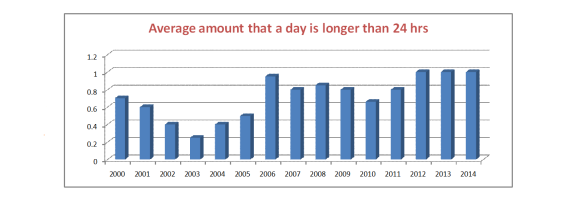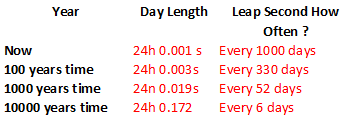On New Year’s Eve an extra second will be added to the end of the day. This extra second is called a leap second. As I’ll explain later, leap seconds need to be added periodically to bring the time we measure with accurate atomic clocks in line with the natural time which results from the rotation of the Earth.
Why do we need leap seconds?
Although we take the average length of a day to be 24 hours, the mean solar day, or average “natural” day measured by the Earth’s rotation, is now slightly longer than this. As discussed in a previous post, this is due to the slowing down of the Earth’s rotation (see note 1). In the year 1900 a day was almost exactly 24 hours, but it is now around 24 hours 0.001 seconds. So, to bring the time measured by accurate atomic clocks to within a second of the natural time, a leap second needs to be added approximately every 1,000 days. The extra second is always added at the end of the day on 30 June or 31 December. The previous two were added on 30 June 2012 and on 30 June 2015.
Problems with leap seconds
It has been possible for around two hundred years to accurately measure the rotation of the Earth, and it is now clear that it is slowing down, which means that the length of the mean solar day is increasing. However, over shorter time-scales things aren’t quite as simple as this. The actual speed of the Earth’s rotation is variable and events such as
- large earthquakes
- movements in the Earth’s crust
- melting of glaciers and
- changes in the mantle (the region of the Earth below the crust)
may temporarily speed it up. So although the trend over decades and centuries is that the days are getting longer, over shorter time-scales the average length of a natural day may actually decrease. This is illustrated in the diagram below which shows, in milliseconds, the amount by which the average length of a day was longer than 24 hours for the years 2000 to 2014. (1 millisecond equals one thousandth of a second.)
This variation means that, unlike leap years, where there are precise rules for determining whether or not a given year will be a leap year, it is not possible to say years in advance when there will be a leap second. A body called the International Earth Rotation and Reference Systems Service (www.iers.org) decides from accurate measurements of the Earth’s rotation when the next leap second will occur.
This announcement is made around six months in advance. For example, the official announcement of the December 31 leap second was made on 6 July 2016 by the following bulletin.
In the past when leap seconds have been applied, a number of data centres and websites around the world experienced system problems and crashed. This was because they could not cope with a minute which contains 61 seconds and interpreted this unforeseen event as a system failure.
The Google approach – smearing time
For the next leap second Google are using an interesting solution to the problem. (Google 2016) For the 20 hour period from 2 pm on 31 December to 10 am on 1 January Google will abolish the normal rules of timekeeping. Instead of normal seconds, they will be using a “Google Second” which is fractionally longer than the usual second. Instead of adding an extra second just before midnight, they are spreading out that extra second throughout this 20 hour period which means that no extra second will be need to be inserted. This is shown in the diagram below:
What will happen in the longer term?
As the length of the day gradually increases, leap seconds will need to added more often. In 100 years time we will have, on average, a leap second once a year and in 1,000 years time we will have 7 leap seconds per year, which is equivalent to one leap second every 52 days.
When will the leap second be added?
The extra second is inserted at 23:59:60 at 31 December 2016, Greenwich Mean Time (GMT) (see note 2). So in the UK which uses GMT in the winter months, it will occur just before midnight. In different parts of the world the leap second will be added at different local times. New York is 5 hours behind GMT, so the extra second will be added at 18:59:60 on 31 December local time. Beijing is 8 hours ahead of GMT and the extra second will be added at 07:59:60 on 1 January. Use it wisely ;-).
Notes
1)The average length of day when calculated over a entire year is just over 24 hours. However, over the course of a year the the actual length of a solar day varies. This variation throughout the year is due to entirely different effects than the slowing of the Earth’s rotation. It is at its longest – 24 hours and 30 seconds – around Christmas day and it is shortest at around 23 hours 59 minutes and 38 seconds in mid September. This is variation is described in more detail in my post September 18 the shortest day.
2) The term Greenwich Mean Time is no longer used by astronomers. Instead, they use two different times which agree with each other to within 1 second.
- Universal Time, often abbreviated to UT1, is the mean solar time, the time determined by the rising and setting of the Sun at the Greenwich Meridian, zero degrees longitude.
- Co-ordinated Universal Time, usually abbreviated to UTC, is the time measured by atomic clocks and is kept to within 1 second of UT1 by the addition of leap seconds.
In common use, Greenwich Mean Time (GMT) is often taken to be the same as UTC, which is the approach I have taken for this post. However, it can also be taken to mean UT1. Owing to the ambiguity of whether UTC or UT1 is meant, and because timekeeping laws usually refer to UTC, GMT is normally avoided in precise writing.
The Greenwich Meridian- Image from Wikimedia Commons
References
Google. Making every (leap) second count with our new public NTP servers. https://cloudplatform.googleblog.com/2016/11/making-every-leap-second-count-with-our-new-public-NTP-servers.html (accessed 7 December 2016).







[…] includes details of the leap second recently added to our clocks, and a new year […]
LikeLike
Well that’s a lot more complicated than I realised.
Thanks for drawing the post to my attention – interesting!
LikeLike
And people are upset that I set my clocks 2 minutes fast. Can’t wait to say “I told you so” in just a few short centuries.
This was a really interesting read! Thanks for doing the research.
LikeLiked by 1 person
Actually, I guess it would only work if my clocks were slow, not fast. Whoops, guess I’ll have to find some other way to feel superior! 🙂
LikeLiked by 1 person
🙂
LikeLike
So, ultimately, will the earth stop turning completely?
LikeLiked by 1 person
An interesting question 🙂
For billions of years the Earth’s speed of rotation has been gradually slowing down as its rotational energy is transferred to the Moon causing the Moon to spiral away from the Earth.(Experimental equipment left on the Moon by the Apollo astronauts has confirmed that the average distance from the Earth to the Moon is increasing by about 4 cm a year.)
In theory, given enough time an equilibrium would eventually be achieved where the Earth rotates on its axis in exactly the same time as the Moon takes to orbit the Earth and the gradual slowing down of the Earth’s rotation would cease.
However, in reality this won’t happen because it would take much longer than the lifetime of The Earth to reach this point. The will be consumed when the Sun becomes a red giant.
LikeLiked by 1 person
Good to know. 😀 … Science fiction-y follow-up … how would things like having a space elevator attached to the planet and decades, maybe centuries, of payload being fired off-planet also effect Earth’s rotation? (assuming the elevator is counterbalanced … and assuming the payload weight isn’t replaced by asteroid mining – for example)
LikeLiked by 1 person
In theory if a large object were carried up in a space elevator it would slow down the Earth’s rotation by an absolutely minuscule amount. This is due to a law of physics known as the conservation of angular momentum. (It is this law which explains why a figure skater who is spinning rapidly will slow down if they put their arms out.)
In reality the effect would be insignificant even if large payloads were launched over centuries, the total masses of all payloads would be insignificant compared to the mass of the Earth. The main cause of the tidal slowing down is the Moon which has roughly one eightieth the mass of the Earth
LikeLiked by 1 person
Could this account for the “global warming” everyone keeps talking about?
LikeLike
What will I do with all that time?
LikeLiked by 2 people
[…] via December 31 2016 Leap Second — The Science Geek […]
LikeLike